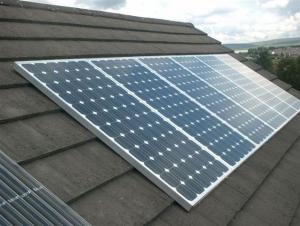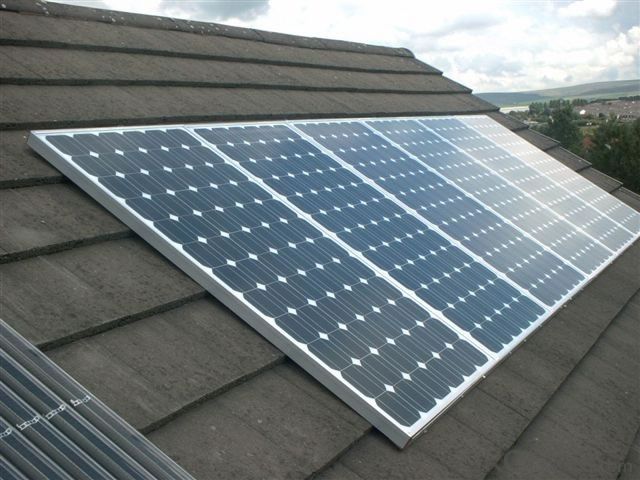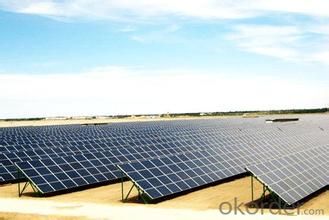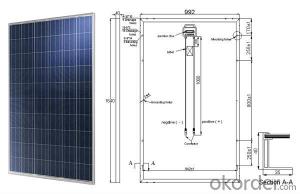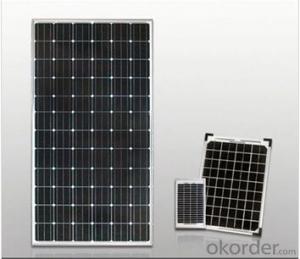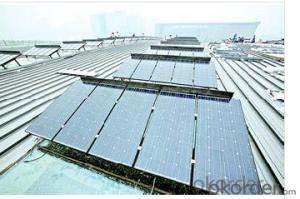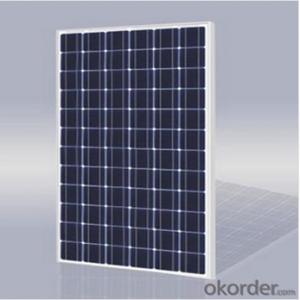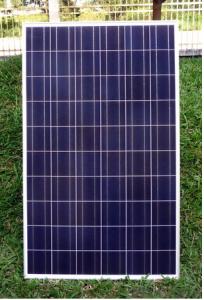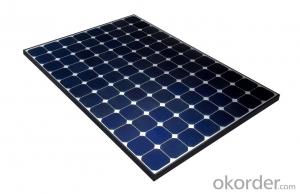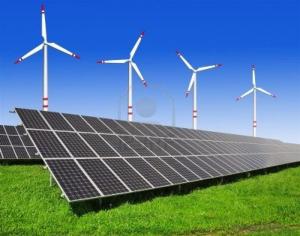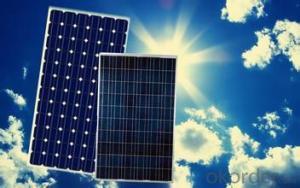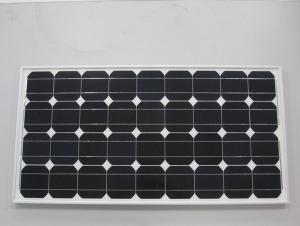30 Watt Solar Panels - 45w CNBM Polycrystalline Silicon Panel for Home Use
- Loading Port:
- Shanghai
- Payment Terms:
- TT OR LC
- Min Order Qty:
- 100 watt
- Supply Capability:
- 1000 watt/month
OKorder Service Pledge
OKorder Financial Service
You Might Also Like
Specification
45W CNBM Polycrystalline Silicon Panel for Home Using
Production description
Most solar modules are currently produced from crystalline silicon (c-Si) solar cells made of multicrystalline andmonocrystalline silicon. In 2013, crystalline silicon accounted for more than 90 percent of worldwide PV production, while the rest of the overall market is made up of thin-film technologies using cadmium telluride, CIGS and amorphous silicon[7]Emerging, third generation solar technologies use advanced thin-film cells. They produce a relatively high-efficiency conversion for the low cost compared to other solar technologies. Also, high-cost, high-efficiency, and close-packed rectangular multi-junction (MJ) cells are preferably used in solar panels on spacecraft, as they offer the highest ratio of generated power per kilogram lifted into space. MJ-cells are compound semiconductors and made of gallium arsenide (GaAs) and other semiconductor materials. Another emerging PV technology using MJ-cells is concentrator photovoltaics (CPV).
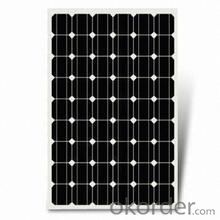
Feature
1.High conversion efficiencies resulting in superior power output performance.
2.Outstanding power output even in low light or high temperature conditions
3.Optimized design for ease of soldering and lamination
4.Long-term stability,reliability and performance
5.Low breakage rate
6.Color uniformaity
Physical characteristic
1. Rigorous quality control meets the highest international standards.
2. High-transmissivity low-iron tempered glass, strong aluminium frame.
3. Using UV-resistant silicon.
4. IS09001/14001/CE/TUV/UL
- Q: My washer is 20 volts 60 gz,9.6 amps. The solar panels I am looking at are: Sharp ND-208U Solar Panels (208 Watt) List Price $,479.99 Only $,049.99 Sharp Solar Panels (208 Watt) List Price $,352.99 Only $,040.99 If I buy that will it be enough to run my washer?
- Solar panels produce power in proportion to the amount of sun light and inverse proportion to the temperature. To use solar power you will need in addition to the panels a bank of batteries a charge controller and an inverter to convert to 20v. The panel(s) will only be used to recharge the batteries and the batteries connected to the inverter is what is going to run your washing machine. You therefore need to know how long is the machine going to run, how often and how much charging can you expect to get from each panel in order to figure out how many panels you will need and how many batteries. If you do only one load very infrequenly, you will be able to use a smaller battery bank and charge at a lower rate.
- Q: How do solar panels impact the electric bill?
- Solar panels can significantly reduce or even eliminate the electric bill. By generating electricity from sunlight, solar panels can offset the amount of power needed from the grid. This means that homeowners or businesses with solar panels can consume less electricity from the utility company, resulting in lower energy bills. In some cases, excess solar energy can be exported back to the grid, earning credits that further reduce the electric bill.
- Q: I've recently started a project to help my store become more green and I need to get some estimates from businesses and if all goes according to plan we will have some panels on our roof and some other measures that I've written into my proposal. Any help is welcome. Just so you know it's a large grocery store in a corporate chain and I've been approved to do all the research, just no promises of payment.
- Google the following: solar panels oregon. Here are a few from the first site listed below. Sorry for the capitalization; that was the site's formatting choice, not mine. SOLAR INC. 3698 Franklin Blvd Eugene, OR 97403 (54) 284-2426 ADVANCED ENERGY SYSTEMS 2990 FOREST BOULEVARD, EUGENE, OR 97405 Phone: (54) 683-2345 ALTERNATIVE POWER MACHINE 4040 HIGHLAND AVENUE, GRANTS PASS, OR 97526 Phone: (54) 476-896 CASCADE SUN WORKS INCORPORATED 2444 SE FIRST STREET, REDMOND, OR 97756 Phone: (54) 548-7887 ENERGY OUTFITTERS LTD. 543 NE E St Grants Pass, OR 97526 (54) 476-4200 ENVIRONMENTAL BUILDING SUPPLIES 89 SE TAYLOR STREET, PORTLAND, OR 9724 Phone: (503) 222-388 KING SOLAR SERVICES 4435 MAPLETON DRIVE, WEST LINN, OR 97068 Phone: (503) 635-5560 MR SUN SOLAR 3838 SW MACADAM AVENUE, PORTLAND, OR 97239 Phone: (503) 222-2468 OERGON SOLAR WATER TALENT, OR 97540 Phone: (54) 535-7332 PROTECH SOLAR 409 PINE STREET, ORETECH, OR 9760 Phone: (54) 882-4545 SOLAR ASSIST 395 CROSS STREET SUITE 2, EUGENE, OR 97402 Phone: (54) 338-4957 SOLAR COLLECTION INCORPORATED 934 PIONEER ROAD, TALENT, OR 97540 Phone: (54) 535-5364 SOLAR DESIGN CONSTRUCTION 825 SE PARK AVENUE, CORVALLIS, OR 97333 Phone: (54) 753-8725 SOLAR ENERGY SOLUTIONS 3730 SE LAFAYETTE COURT, PORTLAND, OR 97202 Phone: (503) 238-4502 SOLAR WIND POWER OF PORTLAND 0006 SW CANYON ROAD, WEST HAVEN SYLVAN, OR 97225 Phone: (503) 297-578 SUMMERS SOLAR SYSTEMS EUGENE, OR 9740 Phone: (54) 683-404 SUMMERS SOLAR SYSTEMS 7342 RAINBOW DRIVE SE, SALEM, OR 97306 Phone: (503) 363-408 SUNBOW SOLAR 074 NW RACHEL STREET, HILLSBORO, OR 9724 Phone: (503) 640-665 SUNLIGHT SOLAR ENERGY 4 NW FRANKLIN AVENUE, BEND, OR 9770 Phone: (54) 322-90 UNITED SOLAR COMPANY 905 SW BUTLER ROAD, GRESHAM, OR 97080 Phone: (503) 666-3065
- Q: will at least consider them for their home electricity? I've seen several articles that new technologies are now being used, but it doesn't seem to be promoted to residential apps. I've even seen that the solar technology will be used in paints in the near future.
- Solar panels are cost effective if they are used over their payback period. The problem is that the down payment is expensive, and the payback period is maybe 0-20 years, so very few people actually expect to own their homes for 0-20 years. It also only really makes sense in areas that buy back electricity generated during the day when you're not using it. In Germany and other european countries, power companies are required to buy back electricity at a higher price than they sell it for--this reduces the payback period and is a great incentive for solar panels. For this reason, they are much more popular over there. Given a little time for the price to fall and given some change in energy policy, solar panels will become more cost effective in the future. Depends on who gets elected, though. There is a solution to the payback period problem, though. Rather than homeowners taking on the long payback period in homes they may not own long enough, some companies are buying panels and leasing them to homeowners. In exchange, homeowners get reduced electric bills, that pay off the lease payments, plus a little extra. I think this is the way to go. check out the link below.
- Q: What is the warranty on solar panels?
- The warranty on solar panels typically varies between 10 to 25 years, depending on the manufacturer.
- Q: How much would it cost (approximately) to convert my home (3 bed. 2 bath) to a green home that is run entirely upon solar panels on my roof? From the panels through installation does anyone know a price break down?
- the st element to comprehend is that there is no longer something complicated some photograph voltaic panel. this is not something greater beneficial than a selection of of photograph voltaic or PV cells on a board this is suited for the main spectacular area of your abode, generally on the roof. There are publications obtainable that coach you the thank you to construct a photo voltaic panel and a windmill for basically $a hundred and fifty, and it’s truly difficulty-free to make. appropriate of all, you may save 70% or greater on your potential invoice, including as much as hundreds of dollars each and each 2 months in reductions. I reviewed the two unfastened publications and paid publications and have arise with our ideal to construct your individual photograph voltaic panels.
- Q: I want to purchase some or one solar panel for my home. I don't know where to buy them from. I've loooked online and if i could buy them online that would be best, but if you knew of a website that has good prices than that would be great!Thanks
- I okorder Hope this helps.
- Q: How do you know when it is a good deal to buy a solar panel. For example, what is a good cost per watt, how many volts should I expect, etc.
- first okorder / example: house roof is 20' x 20' 20' = 240, so sq. inches of roof is = 57,600 say rain fall for your area is 3 per month on average. 57,600 x 3 = 72,800 of rain collected. Using the conversion chart link above, that many cubic inches of water = 750 gallons of water free per month. Look at your water bill and see how much you use. Solar panels take on average 2-20 yrs to pay themselves off, just in time for them to be replaced. Paddle wheels go on for just about forever. We still find large paddle wheel mills in the USA that are over 200 yrs old, and still functioning.
- Q: Where can I buy solar panels other than online in Charlotte, NC?
- You need to be more specific about what type of solar panel. ) PhotoVoltaic (produces electricity) 2) Fluid (Glycol) (heats water or air using a heat exchange tank) 3) Fluid (Water) for pool water heating
- Q: i need as many bad things there is about solar panels
- They require the use of Silicon which requires refining. This process of refining uses non-ecofriendly chemicals. It damages the environment. Solar panels are only about 20-30% efficient whereas coal is around 60-70%. Solar panels require much space for such small output. Do note, that new solar panels are being worked on and that with the correct alignment of solar cells, solar panels may become ~80% efficient, rendering coal useless.
Send your message to us
30 Watt Solar Panels - 45w CNBM Polycrystalline Silicon Panel for Home Use
- Loading Port:
- Shanghai
- Payment Terms:
- TT OR LC
- Min Order Qty:
- 100 watt
- Supply Capability:
- 1000 watt/month
OKorder Service Pledge
OKorder Financial Service
Similar products
Hot products
Hot Searches
Related keywords
